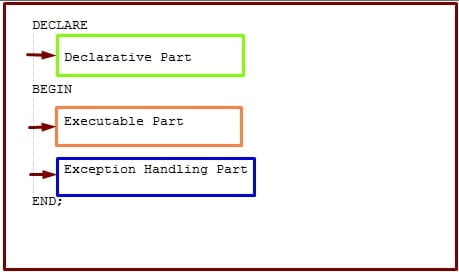Holla!! Friends. Here we start the PL/SQL tutorial, which provides basic and advanced concepts of SQL. Our PL/SQL tutorial will help beginners and professionals both.
PL/SQL – Overview
The full form of PL/SQL is “Procedural Language extensions to the Structured Query Language”. The programs of Oracle PL/SQL are logical blocks that can contain any number of nested sub-blocks.
Introduction to PL/SQL
PL/SQL (Procedural Language for SQL) is Oracle Corporation‘s procedural extension for SQL and the Oracle relational database. The PL/SQL programming language is developed by Oracle Corporation in the late 1980s, PL/SQL is a subset of SQL. PL/SQL is a block-structured language that enables developers to combine the power of SQL with the procedural statement.
Advantages of PL/SQL
- PL/SQL is a development tool that not only supports SQL data manipulation but also provides facilities of conditional checking, branching, and looping.
- It allows sending an entire block of statements to the database all in one go. Which reduces network traffic and provides high performance for the applications.
- PL/SQL also permits dealing with errors as required and displaying the errors in user-friendly messages way.
- It provides a high-security level, it provides access to predefined SQL packages.
- PL/SQL also provides support for Object-Oriented Programming.
The Generic PL/SQL block:

Every programming language allows the creation of structure, logical blocks of code that describe processes, which have to be applied to data. PL/SQL permits the creation of logical design blocks of code that represent processes.
The section of PL/SQL block are:
- Declare section
- The begin and end section that also contains the exception section.
The Declare section:
Codes blocks start with a declaration section, in which memory, variables, and other SQL objected can be declared.
The Begin section:
It forms with a set of SQL and PL/SQL statements, which describe processes, that have to be applied to table data. The actual data manipulation, retrieval, looping, and branching construct are specified in this section.
The exception section:
This section is used for handling error which will arise in manipulation time or execution time of codes. The error can be arises due to syntax, validation, or logic of code.
The End Section:
These are the marks that let us know the end of a PL/SQL block.
FAQS:
1. What is PL/SQL?
ANSWER: PL/SQL (Procedural Language/SQL) is a procedural extension of Oracle – SQL. The Oracle PL/SQL helps the user to develop complex database applications using control structures, procedures, functions, modules, and many more.
2. Differentiate PL/SQL and SQL?
ANSWER: SQL: SQL is a natural language which is very useful for interactive processing.
PL/SQL: PL/SQL is a procedural extension of Oracle – SQL.
3. What is the purpose of using PL/SQL?
ANSWER: PL/SQL is an extension of SQL. While SQL is non-procedural, PL/SQL is a procedural language, It was invented to overcome the limitations of SQL.
4. What are the most important characteristics of PL/SQL?
ANSWER: A list of some notable characteristics:
PL/SQL is a block-structured language. It can be used or portable to all environments that support Oracle.
5. What is Lexical Units?
ANSWER: Words used in a PL/SQL block are called Lexical Units.
In this article, we have discussed the introduction, advantages of PL/SQL. In the coming article, we will learn about how to set up the environment for PL/SQL Tutorial.
Please stay with us 🙂
I was waiting for this tutorial
Thnx for sharing
Informative article
Nice!!
Nice keep it up
Loved the detailing! Keep up the Good work! For any guest post about tutorial we can collaborate too!
Thank you this was informative
Nicely Written.
The tutorial was very detailed yet easy to digest. Liked it
well, detailed! keep up the work.
helpful post
Very nice
I’ve always wondered what PL/SQL stood for. Now I know. Thanks for the article.
Great ❤️